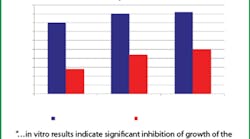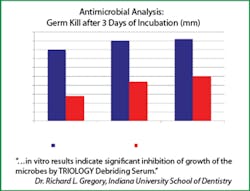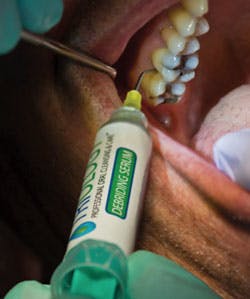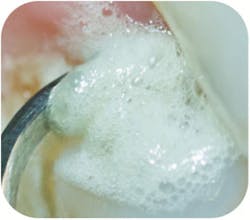By Kim Miller, RDH, BSDH
Philips Online Risk Assessment
In February, Philips introduced a free online patient risk assessment tool called CARE (Customizable Assessment and Risk Evaluator). CARE can evaluate the patient's risk for caries, periodontal diseases, and oral pathology. The caries risk assessment can be used for children as young as six years old. In addition, this tool educates patients as it aids dentists and hygienists in making appropriate treatment recommendations while taking into consideration the patient's personal level of risk.
Also provided on the site is a CDT billing code document with updated, applicable codes for your convenience. Another really helpful feature is the "popup definition." When a word or term is unclear, the popup is available to give a definition, based on evidence. In addition, the CARE tool will soon offer re-evaluation tools so you can reassess your patient's risk at subsequent visits.
Once you have completed the risk assessment questionnaire you can then customize a treatment plan/handout for your patients. The treatment plan can also be customized for your particular office (logo, name, address, etc.). You can print the handout and give it to the patient, and you can save the document to the patient's electronic record. However, none of the patients' data appears on the Philips website to protect patients' privacy and prevent their information from being compromised.
-------------------------------------------------------------
Other articles by Miller
- Piezo scaler, fluoride varnish
- Whitening Prophy Paste, Blanket, Cold Sores
- Instruments, Floss, Interdental ...
-------------------------------------------------------------
To use the CARE tool chairside, an Internet connection is required, even though there is an offline model also available. CARE will lead you through a series of questions gathering patient information. Once you become familiar with the process, it should only take two to three minutes chairside, according to Michelle Hurlbutt, RDH, MSDH, who is a member of the Philips CARE Tool Committee.
For more information, visit the Philips website at www.philipsoralhealthcare.com; enter the site by clinking the US tab and then the Philips CARE tab. At the bottom of the page, you'll see three options: Get Started, Watch Demo (2 minutes long), and Take a CE Webinar. I recommend the demo; it takes you through all the necessary steps and shows how easy it really is.
Triology oral cleansing and care
The Triology NOWsystem was recently introduced as an adjunct to scaling and root planing procedures for in-office and home use. The system includes a debriding rinse and a debriding serum. Both the serum and rinse are a biologic solution (including carbamide peroxide) that, according to the manufacturer, integrates with saliva to provide superior removal of bacteria, fungi, debris, and irritants.
Tritiserum, the blend of ingredients that powers Triology, is a bioactive formula of vitamins, minerals, enzymes, natural antiseptics, and antimicrobial agents. Triology claims to accelerate healing time, as well as reduce pain and inflammation. An in vitro study at the Indiana University School of Dentistry demonstrated a germ kill rate of 2.5 to 3 times that of chlorhexidine gluconate after three days of incubation1 (see Figure 1).
A separate in vitro study at the University of British Columbia in Vancouver studied the effects of carbamide peroxide on oral biofilm. The findings indicated that carbamide peroxide gels and rinses at 5% and 10% concentration, when compared to a 1% chlorhexidine gel, had superior or comparable bactericidal and dislodging effects on oral biofilm.2
The obvious advantage of Triology Debriding Rinse over chlorhexidine gluconate is the absence of additional stain and calculus buildup. In addition, it's safe for long-term use, and there is no negative effect on taste buds. The 8 ounce bottle of Triology Debriding Rinse provides 59 doses while an 8 ounce bottle of cholorhexidine has only 16 doses, making Triology the more cost effective choice.
In-office use includes:
- Pre-rinse day of treatment for one to three minutes reduces airborne bacteria
- Use during procedures involving bleeding/pain to increase patient comfort
- Postoperative rinse after all procedures involving debridement and supragingival oral wounds
- Use following any procedure to reduce pain
At-home use includes:
- Pre-rinse for days or weeks prior to procedure to reduce inflammation, pathogens, or infection
- Daily use for patients with periodontal disease
- Daily use for patients with mouth sores from dentures, appliances, etc.
- Daily use to reduce halitosis
- Daily use to reduce symptoms associated with metallic taste disorders
- Daily use for symptoms of dry mouth to hydrate & moisturize oral tissues
The preloaded syringe of Triology Debriding Serum is used at room temperature subgingivally during scaling and root planing to provide an oxygenating biologic foaming debridement, which, according to the studies, cleans better than water or chemical-based products. The subgingival cleaning action is coupled with a balancing of pH, which increases the potential for accelerated healing and reduced inflammation and pain. The serum should be first applied to the gingival margins of the teeth in the area(s) selected for treatment. Once the foaming has stopped, then express the serum into the bottom of periodontal pockets. The foaming action flushes out bacteria, debris, and irritants from periodontal pockets. The serum can be reapplied up to three times.
Triology Serum may also be used during periodontal maintenance procedures for all types of dentition, including implants, and the product includes a 2 cc syringe and treatment pen. The serum can be used for debridement, scaling, implant and crown procedures, extractions, root planing, and pre- and post-operative procedures. The home use of the serum is provided in a convenient preloaded treatment pen. With this home application, the patient can improve their treatment results.
For more information, visit www.TRIOLOGYcare.com or call (800) 306-3041.
As always, email me at [email protected] with your comments and suggestions of products you would like to see appear in this column.
Author's note: Dear readers, in my March column I indicated that the Pure Newtron line of ultrasonic scalers by Acteon would be available in March. I was wrong. The Pure Newtron line of ultrasonics is not for sale in the United States or Canada pending FDA clearance, which Acteon hopes to have sometime in April. Please forgive the misinformation.
References
1. In Vitro Analysis of Antimicrobial Activity of Wheat Grass-Containing Solutions, Richard L Gregory, PhD., Mucosal Biology Laboratory, Indiana University School of Dentistry, 415 Lansing Street, Rm. OH120, Indianapolis, Indiana 46202
2. Yao CS, Waterfield JD, Shen Y, Haapasalo M, MacEntee MI. In Vitro Antibacterial Effect of Carbamide Peroxide on Oral Biofilm. Journal of Oral Microbiology 2013, 5:20392.









